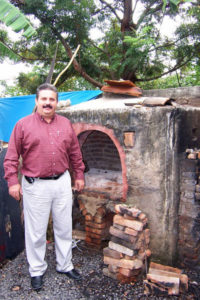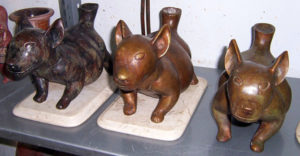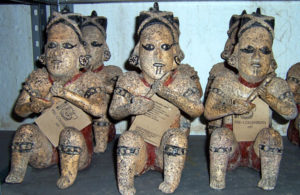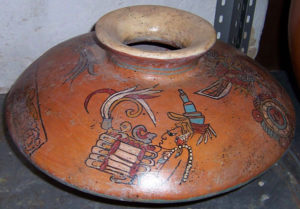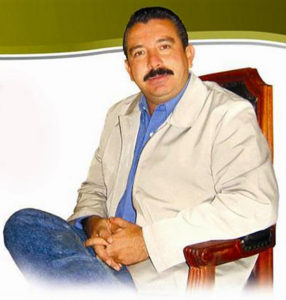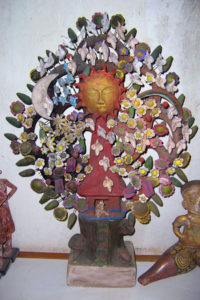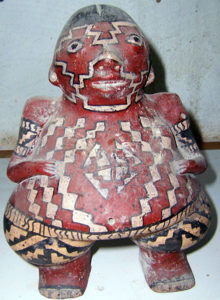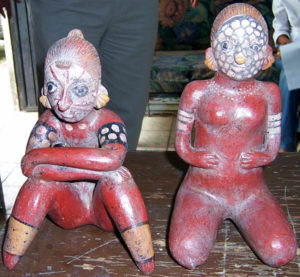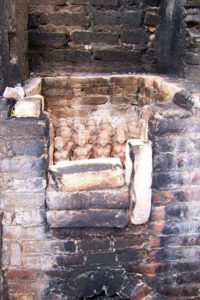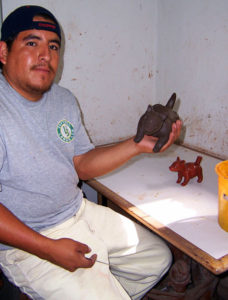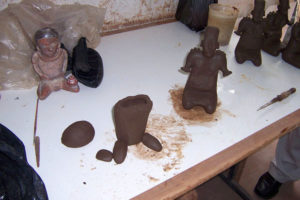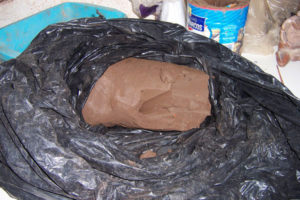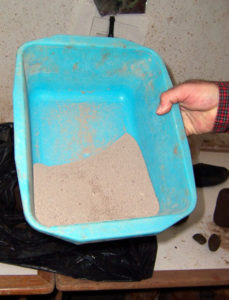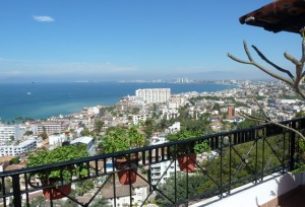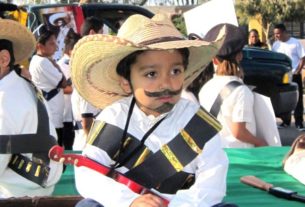Feria Maestros del Arte has been called a “heart” show and not just another “art” show because the artists pay nothing to attend — no booth fee, no percentage of sales. We find local families willing to house them for the three days they are here and we feed them while they are at the show. All the artist needs to do is get to Chapala — and we even help with that if needed.
The purpose of this non-profit effort is to educate the public about Mexico’s disappearing folk and indigenous art. Many artists have already abandoned producing art that had been handed down generation after generation in their family, because they cannot make a living on their art alone.
The Feria also gives the artists a venue to sell to gallery owners, museum buyers and collectors from across the border as well as inside Mexico, hopefully making contacts for continuing sales. Having so many artists in the same place is a huge incentive for buyers from the U.S. to come to the Feria and save the cost and time of traveling around Mexico themselves.
I have traveled throughout Mexico over the last six years looking for artists who exemplify the highest quality in Mexican folk art in all media – clay, textiles, tin, wood, silver, straw and palm, etc. Many of the artists I have sought out are already famous in their particular medium; others are virtually unknown but exhibit the quality of work I require to invite them to attend Feria Maestros del Arte.
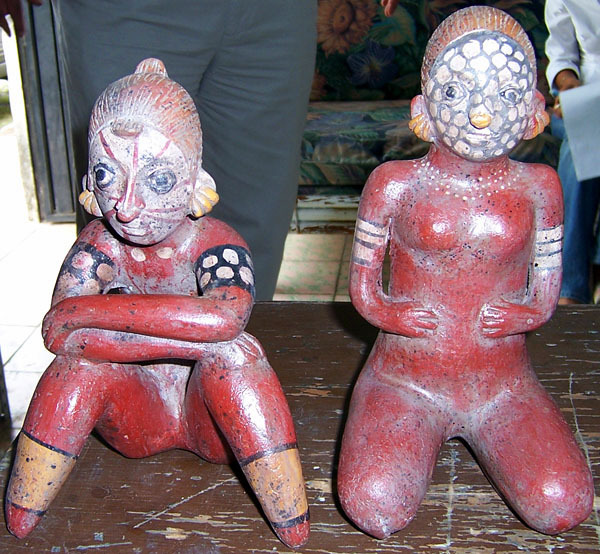
Over the last year in my search for artists for the this year’s November 9 to 11 exhibit, I have learned a valuable lesson – don’t forget to look in your own backyard. The state of Jalisco has hundreds of fine artisans and one doesn’t need to travel far to find them. Most of us realize Tonalá and Tlaquepaque are known for their art but I have just this last week found incredible art right here in Chapala and Ixtlahuacan — our own backyard.
For more than ten years, Javier and Gerardo Degollado have manufactured archaeological reproductions with such great care that the quality of their pre-Columbian reproductions is only minutely different than the original art. Each piece is one-of-a-kind, made by hand, not by using molds. The mission of the Degollado brothers is to maintain the ancient tradition of their Mexican culture.
Pre-Columbian refers to the time in the Americas before the 16th century – before Christopher Columbus arrived in 1492 with the first wave of European colonists and invaders. The Degollados focus on art found in tombs and burial sites found in western Mexico, a region that includes the states of Jalisco, Nayarit, Aguascalientes, Michoacán, Colima and Guanajuato.
Some of the Degollado pieces are barro bruñido, a technique whereby the clay is rubbed and rubbed after it has been fired to burnish it to a lovely sheen – a process Tonalá has become famous for. Study of original art pieces by the Degollados has been authorized by INAH (National Institute of Anthropology and History) in Mexico City and the INAH stamp can be seen on the bottom of the art object.
Their workshops utilize the same principles used centuries ago to produce ceramics or pottery. The clay they use is from Tonalá. It is first ground into a very fine dust and strained to remove impurities. Next water is added to make the clay into a workable medium. Each piece is individually shaped by hand. The artist rolls out a large ball of clay, a smaller ball, four oblong pieces and then proceeds to put them all together to form a man or a woman. They are so precisely made, it is difficult to tell one from the other. Carving and contouring completes the form and then it is set aside to dry. The last step before firing is applying natural earth pigments to add color.
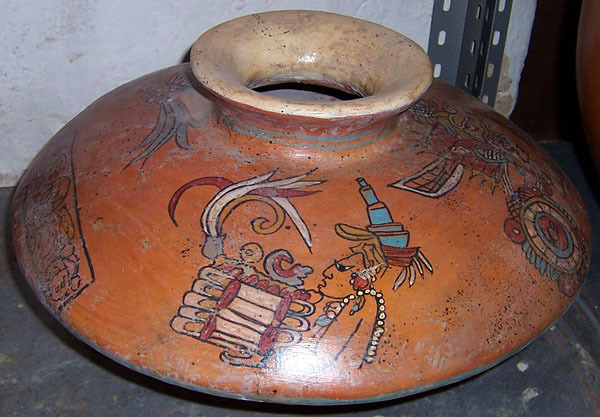
Once a piece has been formed, it is left to dry three to four days before it is fired in brick kilns. The paints are burned into the piece during the firing. After firing, spots are added; this is known as “mushroom patina.” It is these spots that transform the work into what appears to be an authentic pre-Columbian piece of art.
The Aztecs, who are also known as the Mexica (pronounced “meh-SHEE-kah”), were nomadic, warlike people who arrived in central Mexico from the north in the late 13th century AD. They were not well received by the established descendants of the Toltecs, and wandered around the area for decades until 1344 when, according to legend, they received a “sign” that they should build their city Tenochtitlan. The sign was an eagle devouring a snake on a cactus patch. The eagle and snake remain today as the national emblem of Mexico.
In 70 years they expanded their territory to create the largest empire in the history of Mesoamerica. Only a few peoples were able to resist the Aztec onslaught: The Purépechas of Michoacán, the Tlaxcaltecas to the east, and some Mixteca tribes in the southern state of Oaxaca. The Aztecs used political alliances with neighboring peoples, as well as strict military training among their young men, to extend their empire.
The peoples who settled throughout this large empire made historic contributions to science and the arts. Extraordinary examples have been unearthed showing them to have been goldsmiths and ceramicists of the highest caliber. Today, we can admire that greatness in museums or private collections throughout the world. Because pieces of art have survived the centuries, science has been able to study the customs and traditions of these cultures.
The Degollado brothers also manufacture pre-Hispanic reproductions in bronze, this medium guaranteeing the preservation of the art piece by many more years. Their work is so precise and detailed that they have been asked to make miniature replicas, which are then used for jewelry.
Years ago, Chapala had many ceramicists living here. When the lake receded, countless numbers of them left the area to find work elsewhere. Three families who live in nearby Ixtlahuacan work with the Degollado family in hopes of reviving the art of ceramics once plentiful in this area.
One of the more unusual pieces the Degollado brothers make is a Chapalan Arbol de la Vida (tree of life). It is exquisite and very different from the trees of life found in the Metepec, Mexico area. The colors are natural earth pigments and muted, unlike the Metepec trees that are normally painted in rich, vibrant colors.
Gerado Degollado is the current Presidente Municipal or mayor of Chapala. He is dedicated to improving the quality of education in Mexico and working together with Latin American communities in the United States to broaden and strengthen relations between the two countries. He is also committed to bringing more cultural events to the Chapala area and was eager to join Feria Maestros del Arte in its endeavor to increase awareness of Mexican folk and indigenous art.
The Degollados will be exhibiting their work at the event and, although Gerardo has a very busy schedule as mayor, he will also be there to meet and talk to interested buyers.
Hours of the November 9-11 Feria are 10 a.m. to 4 p.m. Admission is 50 pesos/day or all three days for 100 pesos. This year, the exhibition will be held at Club de Yates de Chapala on Paseo Ramon Corona. The Feria website has a page for each of the 58 artists attending with photos and information about the artist, a map showing where the yacht club is, and just about anything else you would want to know about the event.
For information on the Feria Maestros del Arte, contact Marianne Carlson at 011 522 376 765-7485 or email [email protected].

